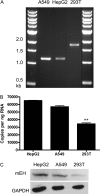The expression of human microsomal epoxide hydrolase is predominantly driven by a genetically polymorphic far upstream promoter
- PMID: 19364907
- PMCID: PMC2700158
- DOI: 10.1124/jpet.109.150870
The expression of human microsomal epoxide hydrolase is predominantly driven by a genetically polymorphic far upstream promoter
Abstract
Microsomal epoxide hydrolase (EPHX1) biotransforms epoxide derivatives of pharmaceuticals, including metabolites of certain antiepileptic medications, such as phenytoin and carbamazepine, and many environmental epoxides, such as those derived from butadiene, benzene, and carcinogenic polyaromatic hydrocarbons. We previously identified a far upstream promoter region, designated E1-b, in the EPHX1 gene that directs expression of an alternatively spliced EPHX1 mRNA transcript in human tissues. In this investigation, we characterized the structural features and expression character of the E1-b promoter region. Results of quantitative real-time polymerase chain reaction analyses demonstrated that the E1-b variant transcript is preferentially and broadly expressed in most tissues, such that it accounts for the majority of total EPHX1 transcript in vivo. Comparative genomic sequence comparisons indicated that the human EPHX1 E1-b gene regulatory region is primate-specific. Direct sequencing and genotyping approaches in 450 individuals demonstrated that the E1-b promoter region harbors a series of transposable element cassettes, including a polymorphic double Alu insertion. Results of reporter assays conducted in several human cell lines demonstrated that the inclusion of the Alu(+/+) insertion significantly decreases basal transcriptional activities. Furthermore, using haplotype block analyses, we determined that the E1-b polymorphic promoter region was not in linkage disequilibrium with two previously identified nonsynonomous single nucleotide polymorphisms (SNPs) in the coding region or with functional SNPs previously identified in the proximal promoter region of the gene. These results demonstrate that the upstream E1-b promoter is the major regulator of EPHX1 expression in human tissues and that polymorphism in this region may contribute an interindividual risk determinant to xenobiotic-induced toxicities.
Figures





Similar articles
-
Sp1 and Sp3 transcription factors regulate the basal expression of human microsomal epoxide hydrolase (EPHX1) through interaction with the E1b far upstream promoter.Gene. 2014 Feb 15;536(1):135-44. doi: 10.1016/j.gene.2013.11.053. Epub 2013 Dec 4. Gene. 2014. PMID: 24315822 Free PMC article.
-
Microsomal epoxide hydrolase 1 (EPHX1): Gene, structure, function, and role in human disease.Gene. 2015 Oct 15;571(1):1-8. doi: 10.1016/j.gene.2015.07.071. Epub 2015 Jul 26. Gene. 2015. PMID: 26216302 Free PMC article. Review.
-
Expression of a novel mRNA transcript for human microsomal epoxide hydrolase (EPHX1) is regulated by short open reading frames within its 5'-untranslated region.RNA. 2013 Jun;19(6):752-66. doi: 10.1261/rna.037036.112. Epub 2013 Apr 5. RNA. 2013. PMID: 23564882 Free PMC article.
-
Alternative promoters determine tissue-specific expression profiles of the human microsomal epoxide hydrolase gene (EPHX1).Mol Pharmacol. 2005 Jan;67(1):220-30. doi: 10.1124/mol.104.005579. Epub 2004 Oct 1. Mol Pharmacol. 2005. PMID: 15465926 Free PMC article.
-
Epoxide hydrolase--polymorphism and role in toxicology.Toxicol Lett. 2000 Mar 15;112-113:365-70. doi: 10.1016/s0378-4274(99)00235-0. Toxicol Lett. 2000. PMID: 10720753 Review.
Cited by
-
Sp1 and Sp3 transcription factors regulate the basal expression of human microsomal epoxide hydrolase (EPHX1) through interaction with the E1b far upstream promoter.Gene. 2014 Feb 15;536(1):135-44. doi: 10.1016/j.gene.2013.11.053. Epub 2013 Dec 4. Gene. 2014. PMID: 24315822 Free PMC article.
-
Microsomal epoxide hydrolase 1 (EPHX1): Gene, structure, function, and role in human disease.Gene. 2015 Oct 15;571(1):1-8. doi: 10.1016/j.gene.2015.07.071. Epub 2015 Jul 26. Gene. 2015. PMID: 26216302 Free PMC article. Review.
-
System review and metaanalysis of the relationships between five metabolic gene polymorphisms and colorectal adenoma risk.Tumour Biol. 2012 Apr;33(2):523-35. doi: 10.1007/s13277-011-0287-x. Epub 2011 Dec 13. Tumour Biol. 2012. PMID: 22161138 Review.
-
Intronic DNA elements regulate Nrf2 chemical responsiveness of the human microsomal epoxide hydrolase gene (EPHX1) through a far upstream alternative promoter.Biochim Biophys Acta. 2014 Jun;1839(6):493-505. doi: 10.1016/j.bbagrm.2014.03.014. Epub 2014 Apr 2. Biochim Biophys Acta. 2014. PMID: 24704207 Free PMC article.
-
Is there a role for MDR1, EPHX1 and protein Z gene variants in modulation of warfarin dosage? a study on a cohort of the Egyptian population.Mol Diagn Ther. 2014 Feb;18(1):73-83. doi: 10.1007/s40291-013-0055-2. Mol Diagn Ther. 2014. PMID: 24092646
References
-
- Barrett JC, Fry B, Maller J, and Daly MJ (2005) Haploview: analysis and visualization of LD and haplotype maps. Bioinformatics 21 263-265. - PubMed
-
- Brøgger J, Steen VM, Eiken HG, Gulsvik A, and Bakke P (2006) Genetic association between COPD and polymorphisms in TNF, ADRB2 and EPHX1. Eur Respir J 27 682-688. - PubMed
-
- Collins AR, Gedik CM, Olmedilla B, Southon S, and Bellizzi M (1998) Oxidative DNA damage measured in human lymphocytes: large differences between sexes and between countries, and correlations with heart disease mortality rates. FASEB J 12 1397-1400. - PubMed
-
- Crawford DC and Nickerson DA (2005) Definition and clinical importance of haplotypes. Ann Rev Med 56 303-320. - PubMed
-
- Davuluri RV, Suzuki Y, Sugano S, Plass C, and Huang TH (2008) The functional consequences of alternative promoter use in mammalian genomes. Trends Genet 24 167-177. - PubMed
Publication types
MeSH terms
Substances
Grants and funding
LinkOut - more resources
Full Text Sources
Research Materials
Miscellaneous

